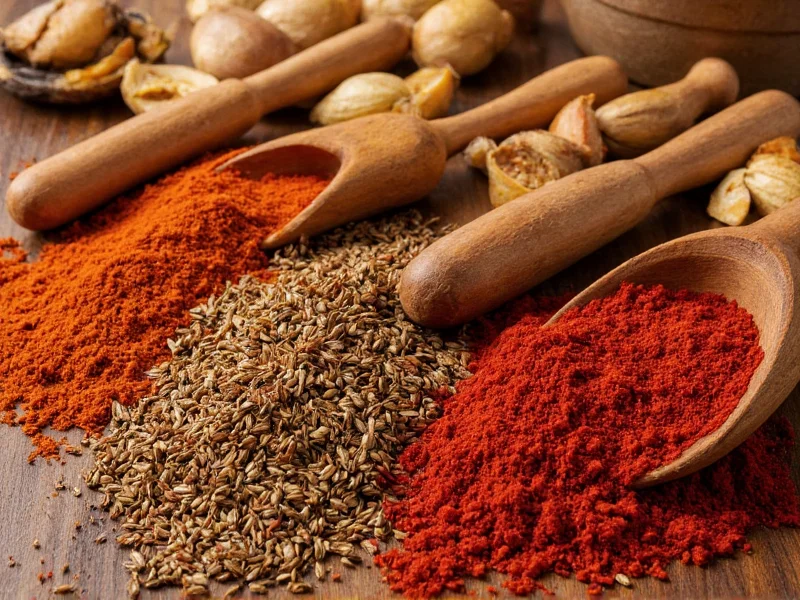Understanding spices food items begins with recognizing their botanical origins and culinary applications. These potent flavor enhancers have shaped global trade routes, cultural cuisines, and even historical events. From ancient spice markets to modern kitchen pantries, these dried plant derivatives remain indispensable in cooking traditions worldwide.
Defining Spices: Beyond Basic Flavor Enhancement
Spices food items differ fundamentally from herbs in both origin and intensity. While herbs typically come from the leafy portions of plants and offer fresh, grassy notes, spices derive from other plant structures:
| Plant Component | Spice Examples | Flavor Profile |
|---|---|---|
| Seeds | Cumin, coriander, mustard | Earthy, nutty, pungent |
| Roots | Ginger, turmeric | Warming, peppery, earthy |
| Bark | Cinnamon, cassia | Sweet, woody, aromatic |
| Flower Buds | Cloves, saffron | Pungent, floral, intense |
| Fruits | Peppercorns, allspice | Peppery, complex, warm |
This botanical classification explains why certain spice food items maintain potency when dried, while herbs often lose vibrancy. The concentrated essential oils in spices survive dehydration better than the volatile compounds in leafy herbs.
Historical Significance of Spice Food Items
Spices have influenced human civilization for millennia. Ancient Egyptians used cinnamon in embalming rituals, while Roman elites considered pepper valuable enough to pay ransoms. The quest for spice food items drove European exploration, leading to colonial expansions and global trade networks. Understanding this historical context reveals why certain spices remain culturally significant across different regions today.
Health Benefits of Common Spice Food Items
Modern research validates many traditional medicinal uses of spice food items. Turmeric contains curcumin, a compound with anti-inflammatory properties. Cinnamon may help regulate blood sugar levels, while ginger demonstrates effectiveness against nausea. Black pepper enhances nutrient absorption through piperine. However, these benefits typically require consistent dietary inclusion rather than medicinal supplementation.
When exploring health benefits of spice food items, consider these evidence-based findings:
- Garlic (technically a spice when dried) shows cardiovascular benefits
- Cloves contain eugenol, which has dental pain-relieving properties
- Cumin may improve digestion and iron absorption
- Saffron demonstrates potential mood-enhancing effects
Practical Guide to Using Spice Food Items
Maximizing flavor from spice food items requires proper handling techniques. Whole spices maintain freshness significantly longer than ground versions. Toasting whole spices before grinding releases essential oils, intensifying flavor. Different cooking methods affect spice performance—adding delicate spices like saffron late in cooking preserves their nuanced flavors, while robust spices like cumin benefit from longer cooking times.
Storage Recommendations for Longevity
Proper storage extends the shelf life of spice food items. Keep them in airtight containers away from light, heat, and moisture. Whole spices typically remain potent for 2-4 years, while ground spices last 6 months to 2 years. Freezing extends shelf life but requires careful moisture control. Regularly check for faded color or diminished aroma as indicators of diminished quality.
Global Spice Blends: Cultural Culinary Signatures
Traditional spice blends showcase regional flavor preferences and historical trade influences. These combinations demonstrate how cultures have perfected spice food items pairings over generations:
- Garam Masala (India): Warm blend of cardamom, cinnamon, cloves, and cumin
- Ras el Hanout (North Africa): Complex mix featuring rose petals, lavender, and 20+ spices
- Chinese Five-Spice: Balanced combination of star anise, cloves, cinnamon, Sichuan pepper, and fennel
- Adobo Seasoning (Latin America): Garlic, oregano, cumin, and citrus-forward blend
- Herbes de Provence (France): Though primarily herbal, often includes lavender as a spice component
Selecting Quality Spice Food Items
When purchasing spice food items, look for vibrant color and strong aroma as indicators of freshness. Reputable sources often provide harvest dates or origin information. Organic spice food items may offer reduced pesticide exposure, though flavor differences are minimal. Consider buying small quantities initially to test quality before larger investments. Specialty spice merchants often provide superior freshness compared to supermarket options.
Common Misconceptions About Spices
Several myths persist about spice food items. Contrary to popular belief, spicy heat comes primarily from capsaicin in chilies (technically fruits, not spices). The term "Indian food is always spicy" oversimplifies diverse regional cuisines. Additionally, while some spices have medicinal properties, they shouldn't replace professional medical treatment for health conditions.
Integrating Spices Into Daily Cooking
Beginners should start with versatile spice food items like cumin, paprika, and black pepper before exploring more complex blends. Keep a simple spice rotation system to prevent waste. Experiment with single-spice additions before combining multiple flavors. Remember that spice intensity varies by brand and freshness—always start with smaller amounts and adjust to taste.
Conclusion: Embracing the World of Spices
Spice food items represent one of humanity's oldest culinary tools, transforming simple ingredients into complex, memorable dishes. By understanding their origins, properties, and proper usage, home cooks can elevate their culinary creations while potentially gaining associated health benefits. The journey through spice food items exploration offers endless opportunities for discovery, connecting modern kitchens to ancient traditions and global cultures through the universal language of flavor.











 浙公网安备
33010002000092号
浙公网安备
33010002000092号 浙B2-20120091-4
浙B2-20120091-4